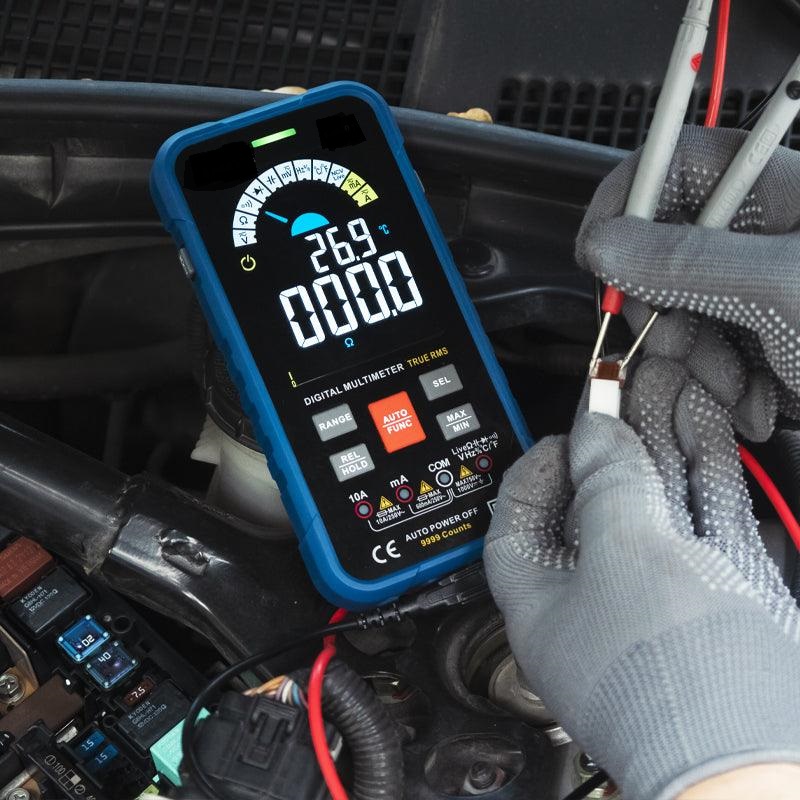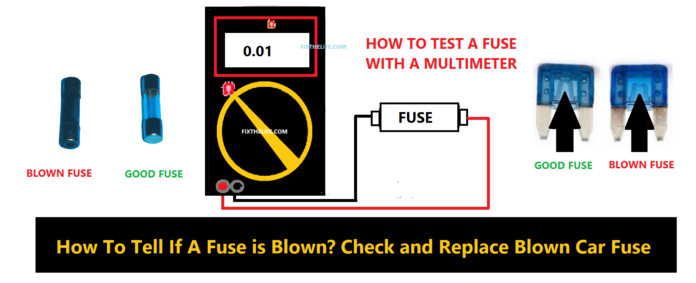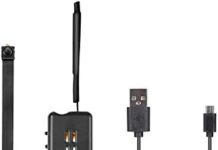How to tell if a fuse is blown? We are here for you with the detailed guide. Fuses are a crucial component of any electrical system, playing a vital role in protecting the wiring from excessive currents and faults. Identifying the condition of a blown or removed fuse can be challenging. This article examines various aspects of fuses, including techniques for testing if a fuse has blown and instructions for replacing it.
We will also cover information on how to tell if a car fuse is blown and how to replace them.
Continue reading to know how to tell if a fuse is blown, how to tell if a car fuse is blown and how to replace them.
Key Points Covered in The Article
- Fuses are essential components of electrical systems that protect the wiring from excessive currents and faults.
- Fuses act as gatekeepers and “blow” when the current exceeds safe levels, cutting off the power flow to prevent damage or danger.
- Fuses come in different sizes and strengths, matching the needs of specific devices and circuits.
- There are different types of fuses, including one-time-only fuses, resettable fuses, current-limiting fuses, and non-current-limiting fuses.
- Fuses can be found in various applications like homes, cars, and industrial equipment.
- To check if a fuse is blown, you can visually inspect it for signs of damage or use a multimeter for a more precise test.
- Replacing a fuse involves turning off the power, removing the old fuse, and inserting a new one of the same rating.
- Fuses differ from circuit breakers in terms of construction, operation, number of uses, switching action, characteristic curve, reliability, operating voltage, type of protection, status indicator, maintenance, operating time, cost, size, adjustability, and endurance.
- Fuses offer advantages such as ease of use and replacement, quick response time, lower initial cost, less wear and tear, smaller space requirement, no regular maintenance, consistent protection, and lower replacement cost.
- Circuit breakers have advantages like requiring more knowledge and skill, providing a fast response with a slight delay, offering more adjustability, accommodating higher voltage applications, protecting against both overloads and short circuits, and having a longer lifespan.
What is a Fuse?
In electrical systems, a fuse is like a superhero that protects the entire system from getting overwhelmed by too much electrical current.
Imagine it as a small, sacrificial part that acts as a gatekeeper. When things get too intense, and the current goes beyond safe levels, the fuse “blows” and cuts off the power flowing through it.
It’s like hitting the emergency stop button to prevent any damage or danger.
Fuses come in different sizes and strengths, depending on how much current they can handle. They are designed to match the needs of specific devices and circuits.
Think of it as having different superheroes with different powers for different situations.
Did you know that the first person to come up with the idea of a fuse was Thomas Edison? Back in 1890, he invented a simple type of fuse using a wire that connected the power line to the neutral.
When too much current passes through it, the wire breaks and stops the flow of electricity.
So, in a nutshell, a fuse is like a guardian that keeps our electrical systems safe by sacrificing itself when things get too intense. It’s a simple yet crucial component that helps ensure our devices and circuits stay protected.
How Does a Fuse Work?
Imagine a fuse as a superhero that protects electrical devices from getting hurt. It’s like a tiny wire inside a special box. This wire is made of a material that can melt when too much electric current flows through it. But why is that important?
Well, you know how some devices have different buttons or switches to control them? Those buttons and switches are connected to something called a circuit.
A circuit is like a pathway that allows the electric current to flow from the power source to the device.
Now, let’s say there’s a problem with the circuit, like too much current flowing because of a short circuit or too many things using power at once. That’s when the fuse jumps into action.
The fuse is connected to the circuit, and when it senses that the current is getting out of control, it does something amazing.
The fuse wire starts to get hot and melts if it gets too hot. When it melts, it breaks the pathway of the circuit, like a gate shutting down.
Why does it do that? Well, when there’s too much current, it can damage the electrical devices. So, the fuse sacrifices itself to protect them. By breaking the circuit, stops the current from going any further and saves the devices from harm.
But remember, once the fuse has done its job, it needs to be replaced with a new one. It’s like a hero that can only save the day once.
So, if you notice that your device stops working suddenly, it might be because the fuse has melted, and it’s time to get a new one.
That’s why fuses are so important. They are like little superheroes that keep our electrical devices safe from dangerous currents.
Different Types of Fuses

There are different types of fuses that have specific jobs, but the basic idea behind all of them is quite simple. Fuses act as safety guards in electrical circuits. When too much electric current passes through, they “blow” and stop the flow of electricity.
Let’s dive into the four main types of fuses:
One-time-only fuse
These fuses are like one-time heroes. Once they blow, they can’t be used again. They are the most common type and are affordable and easy to use.
Resettable fuse
Imagine a fuse that gets a second chance. These fuses are pretty cool because they can be reset after blowing. They have a special power that automatically opens the circuit when the current goes beyond a certain limit.
Current-limiting fuse
These fuses are like superheroes with the ability to minimize the impact of overcurrents. When too much current flows, they step in and create a high resistance. This resistance reduces the duration and strength of the overcurrent, helping to keep things under control.
Non-current limiting fuse
Picture a fuse that uses an electric arc to protect the circuit. When there’s an overcurrent, it creates an electric arc that produces a lot of heat. This heat increases the fuse’s resistance and breaks the circuit, stopping the flow of electricity.
These fuses can be a bit slower to respond because they need to build up that electric arc before acting, but they get the job done.
So, fuses are like little superheroes that keep electrical circuits safe. They have different powers and are used for different purposes.
Some blow once and need to be replaced, while others can be reset. They all work together to make sure the electrical currents stay at safe levels and protect our devices from damage.
Some Other Types of Fuses
Let’s take a look at some common types of fuses:
DC fuse
Imagine you have a battery-powered device. A DC fuse is like a superhero that protects it. It’s a bigger fuse because it deals with a constant current. If too much current flows, the fuse blows and stops the flow of electricity, preventing any damage.
AC fuse
Now think about the electricity in your house that comes from the power outlets. An AC fuse is like a mini superhero. Since the current changes direction, the fuse doesn’t need to be as big. It’s designed to stop any sustained arcs that might occur if something goes wrong.
Cartridge fuse
Have you ever seen those cylindrical fuses in some appliances? That’s a cartridge fuse. It’s like a metal strip inside a protective casing. The great thing about it is that it’s easy to change when it blows. Just pull out the old one and put in a new cartridge fuse.
Blade fuse
When it comes to cars and some electronics, you might find blade fuses. They’re like little cartridges with two flat blades. These fuses can be directly plugged into a holder, so it’s simple to replace them if needed.
Bolted fuse
For heavy-duty stuff that requires a lot of power, like machinery or industrial equipment, there are bolted fuses. They have special copper lugs on the ends that make it easier and faster to connect and disconnect them.
Rewireable fuse
Imagine a fuse that you can fix or replace yourself. That’s a rewireable fuse. It comes pre-connected to wires and can be readily replaced with a new one when it blows. They come in standard sizes, making it easy to find a replacement.
Striker-type fuse
This fuse is a bit different because it doesn’t have a physical element inside. Instead, it uses electronic magic to detect when there’s too much current. Once it senses an overcurrent situation, it quickly interrupts the circuit to keep things safe.
Drop-out fuse
Drop-out fuses are like special protectors for outdoor transformers. If there’s an overload, they have a clever way of dealing with it. The fuse element melts and drops down, breaking the electrical connection and stopping the power flow.
HRC fuse
HRC fuses are like superheroes for high-current situations. They can handle a lot of power and are used in places where circuit breakers might be too big. They have a special mechanism that operates when there’s a high current, keeping everything under control.
So, fuses are like superheroes of the electrical world. They come in different types and sizes, each with its own special powers to protect devices and circuits from too much current. Whether it’s in your home, car, or other equipment, fuses play an important role in keeping things safe and preventing damage.
How to Tell if a Fuse is Blown?

Okay, let’s talk about fuses and how to know if they’re blown. Fuses are like little protectors in an electrical system. They’re there to make sure nothing bad happens when there’s too much electric current flowing.
The easiest way to check if a fuse is blown is by looking at it. If you see that the fuse looks burned or broken, then it’s probably blown. You can usually pop it out from its place to take a closer look.
But wait; Before you do anything, make sure to be safe. If the fuse is inside a cover that needs a screwdriver to open, you should turn off the power from the main electrical panel or unplug the appliance.
Once you’re ready, use a screwdriver to open the cover and get to the fuse. Take a good look at it. If you notice any black stuff or see a broken wire inside the fuse, that’s a sign that it’s blown and needs to be replaced.
If you’re not sure, just by looking at it, you can do a little test with a multimeter. A multimeter is a handy tool that measures electricity. By using it, you can get a more precise answer about whether the fuse is blown or not.
Remember, if the fuse is blown, it’s important to replace it with a new one that has the same rating. Fuses are there to protect your electrical system and appliances, so it’s crucial to make sure they’re working properly.
Now you know how to check if a fuse is blown and what to do if it is. Stay safe and be smart when dealing with electricity.
How to Test a Fuse with a Multimeter?

Here’s a reliable way to test and tell if a fuse is blown. The process is simple:
- Turn off the power at the mains and disconnect the appliance.
- Remove the fuse from the appliance.
- Use a multimeter and set it to measure continuity, which checks if the circuit is complete.
- To ensure the probes are working, touch the negative and positive leads together and listen for a beep or check if the meter indicates continuity.
- Place one probe on each end of the fuse. It doesn’t matter which end of the fuse touches the positive or negative terminal.
- Place the other probe on the opposite end of the fuse.
- If the multimeter beeps and shows continuity, then it’s likely that your fuse is intact. If there is no beep and no continuity, it means the fuse is blown.
- You can also use the resistance setting on the multimeter to test the fuse. This will indicate the amount of resistance present in the fuse. A blown fuse will display infinite resistance or an ‘OL’ (open loop) value.
By following these steps and using a multimeter, you can test a fuse and determine if it’s blown or not. Always prioritize safety and exercise caution when dealing with electricity.
How to change a fuse?
Replacing a fuse is actually quite simple. Here’s what you’ll need:
- A new fuse that’s the same as the old one
- A screwdriver
- Pliers
Now, let’s go through the steps:
- If you’re changing a fuse in a fuse box or electrical panel, start by turning off the power.
- Use a screwdriver to take off the cover of the fuse holder. It’s like opening a little door.
- Now, you’ll see the old fuse inside. Use pliers to carefully pull it out. Sometimes, you can even do it with your hands.
- Take the new fuse, the one that looks just like the old one, and put it in the same spot where the old one was.
- Make sure the new fuse fits snugly in the holder. It should be nice and tight.
- Turn the power back on. Now the circuit is connected again.
- To be sure everything is working, turn on the appliance that the fuse is connected to. If it works fine, then great job, You did it.
If the appliance doesn’t work or there’s still a problem, it might mean the new fuse isn’t working. You can check it with a special tool called a multimeter, but it’s a bit more advanced. In that case, it’s best to ask someone who knows about fuses, like an electrician, to help you out.
Remember, some fuses can be a bit tricky to change, especially the ones on things like motherboards and circuit boards. It’s always a good idea to get help from a professional for those.
But for most household fuses, following these steps should do the trick. Good luck, and be safe.
What is The Difference Between a Fuse and a Circuit Breaker?

Fuses | Circuit Breakers | |
|---|---|---|
| Construction | Uses a thin strip of metal that melts when there is an overload | Utilizes a bimetallic strip or electromagnetism to break the circuit |
| Operation | Melts when current exceeds the rating | Trips when there is an overload or short circuit |
| Number of Uses | Typically one-time use, needs to be replaced | Resettable and can be used multiple times |
| Switching Action | No switching action, operates in a binary state (good or blown) | Can be manually switched on/off |
| Characteristic Curve | Curve may change over time as the fuse ages | Curve remains consistent |
| Reliability | More reliable due to absence of moving parts | May have moving parts that can fail |
| Operating Voltage | Lower voltage applications like homes and electronics | Higher voltage applications like industrial systems |
| Type of Protection | Protects against overloads | Protects against both overloads and short circuits |
| Status Indicator | Most fuses do not have indicators | Often have indicators (e.g., green or red light) |
| Maintenance | Generally maintenance-free | May require occasional servicing |
| Operating Time | Very fast, typically within milliseconds | Slightly slower, usually within a few milliseconds |
| Cost | Generally less expensive | Often more expensive |
| Size | Smaller in size | Larger in size |
| Adjustability | No adjustability, needs replacement after blowing | Resettable, can be used again after tripping |
| Endurance | Has a limited lifespan, requires replacement | Long-lasting, can serve for many years |
Advantages of Using a Fuse Over a Circuit Breaker?
| Aspect | Fuses | Circuit Breakers |
|---|---|---|
| Ease of use and replacement | Easy plug-and-play | Requires more knowledge and skill |
| Quick response time | Instantly breaks circuit | Fast response, slight delay possible |
| Lower initial cost | Typically cheaper | Can be more expensive |
| Less wear and tear | No moving parts | Some parts can wear out |
| Smaller space requirement | Takes up less space | Requires more space |
| No regular maintenance | Low maintenance | May require periodic servicing |
| Consistent protection | Reliable on-off switch | Protection may vary |
| Replacement cost | Inexpensive | Can be costly, professional installation may be required |
Fuses and circuit breakers are both used to protect electrical circuits from too much electricity flowing through them. They work in slightly different ways, and here are the key differences explained:
Ease of use and replacement
Fuses are super easy to use because you don’t have to do anything special. They are like plug-and-play devices. If a fuse blows out, you can simply replace it with a new one.
Circuit breakers, on the other hand, require a bit more knowledge and skill to install and replace.
Quick response time
Fuses are like superheroes when it comes to responding quickly to problems. If there’s too much electricity flowing through them, they instantly break the circuit to stop any damage.
Circuit breakers are also fast but may take a tiny bit longer to detect and stop the flow of electricity.
Lower initial cost
If you’re thinking about the money side of things, fuses are usually cheaper than circuit breakers. So, if you’re on a budget, fuses might be the way to go for certain situations.
Less wear and tear
Fuses are built to last because they don’t have any moving parts that can wear out. Circuit breakers, on the other hand, have some parts that can get tired and fail over time, so they may need replacement more often.
Smaller space requirement
When it comes to size, fuses take up less space than circuit breakers. This makes them a good choice when you have limited space to work with.
No regular maintenance
Fuses are pretty low maintenance. Once you install them, you don’t have to worry about doing anything else to keep them working. Circuit breakers, on the other hand, might need some servicing to keep them in good shape.
Consistent protection
Fuses provide reliable protection because they either work or they don’t. They’re like an on-off switch for safety. Circuit breakers can sometimes have problems, so their protection might not always be consistent.
Replacement cost
If a fuse blows out, you can easily replace it with a new one. It’s not expensive at all. Circuit breakers, on the other hand, can be a bit pricey to replace, and you might need professional help to install them correctly.
Advantages of Using a Circuit Breaker Over a Fuse?
| Aspect | Circuit Breakers | Fuses |
|---|---|---|
| Build quality/strength | Dead front, no exposed live parts | Exposed live parts |
| Flexibility/adjustability | Can be switched off and reset | Cannot be switched off or reset |
| Dual sensitivity | Detects overcurrent and overheating | Detects overcurrent only |
| External status indicator | Has an indicator to show tripped state | No built-in indicator |
| Higher safety | Less prone to incorrect replacements | Prone to incorrect replacements |
| Startup tripping | Can handle high startup current | Sensitive to high startup current |
| Can be used as ON/OFF switch | Can be used as a switch | Cannot be used as a switch |
| Ground fault protection | Can detect and prevent ground faults | No ground fault protection |
| Aging | Less likely to fail with age | Can become weak and brittle over time |
Build quality/strength
A circuit breaker is designed to be really safe. It has a cover that keeps the important parts hidden, so you won’t accidentally touch anything dangerous.
Fuses, on the other hand, have parts that are exposed, and if you touch them while the electricity is flowing, you might get shocked.
Flexibility/adjustability
Circuit breakers are like superheroes because you can turn them off when you want. It’s like having a switch that you can use to control the electricity in your house.
But fuses can’t be turned off or on like that. Once they blow, you have to replace them.
Dual sensitivity
Circuit breakers are like smart machines. They can detect when there’s too much electricity or if something is getting too hot. They will stop the flow of electricity to protect you and your home.
Fuses, on the other hand, only know when there’s too much electricity. They don’t sense heat or other problems.
External status indicator
Circuit breakers have a cool feature that shows you if they have tripped or not. It’s like a light that turns on or off, so you can easily see if there’s a problem.
But with fuses, you have to look closely at them to figure out if they have blown or not. There’s no special light to help you.
Higher safety
Sometimes, people can make mistakes when replacing fuses. They might put the wrong size or even use something else instead of a fuse.
But with circuit breakers, it’s harder to make those mistakes. You can’t trick them or use the wrong one. So circuit breakers are safer in that way.
Startup tripping
When you turn on something like a big machine or an air conditioner, it needs more electricity at the beginning. Circuit breakers can handle that extra electricity without any problem.
But fuses can be a bit sensitive, and they might blow if there’s too much electricity during startup. To avoid that, you might need a bigger fuse.
Can be used as an ON/OFF switch
Circuit breakers are like switches that you can use to turn things on or off. It’s really convenient because you can control the electricity flow easily.
Fuses, on the other hand, can’t be turned on or off like that. They either work or blow, and you have to replace them.
Ground fault protection
Circuit breakers are smart enough to detect when the electricity is going where it shouldn’t, like through the ground. They can stop it before it causes any danger, like a fire.
But fuses can’t do that. They only blow when there’s too much electricity, but they don’t know about the ground faults.
Aging
As circuit breakers get older, they can still do their job well. They don’t wear out easily. But fuses can become weak and brittle over time. This means they might blow more easily, which can be dangerous for your home’s electrical system.
Remember, both fuses and circuit breakers are important for keeping our homes safe from electrical problems. They have their own strengths and weaknesses, and electricians know which one to use in different situations.
Symptoms of a Blown Car Fuse
Sometimes, a car fuse can stop working, and there are a few signs that can tell you if this has happened. You can take out the fuse from its place and look at it closely.
If you see a gap in the wire or a dark smudge inside the glass, that means the fuse is blown and needs to be replaced.
To get a new fuse, you can go to a parts store and buy one that matches the same size and voltage as the old one. If you need help, you can also contact a professional car repair Service, and they can assist you.
To be sure that the new fuse is the right one, you can use a special tool called a multimeter. It can help you measure the voltage of the fuse. You can find these multimeters available for purchase online, like on Amazon.
When a car fuse blows, it usually happens because there is too much electrical current flowing through the circuit. This can cause problems with different things in your car.
For example, your lights inside and outside the car may not work properly anymore. The radio and other devices you use might also stop working.
Even the important features like the powertrain, driver-assist systems, and safety features can be affected.
So if you notice any issues with these things, it’s likely that a fuse has blown. Replacing the blown fuse with a new one can help fix the problems and prevent them from getting worse.
What Are The Causes Behind a Blown Car Fuse
Sometimes, a car fuse can blow, which means that one of the electrical parts in your car stops working properly. When this happens, there is too much electricity flowing through that part, and it can cause problems.
It can affect different things in your car, like the systems that make the car run or the ones that keep you safe and comfortable inside.
Having the right protection for these fuses is really important for your car to work correctly.
If there is too much electricity going through a part that can’t handle it, it can get really hot, melt, or even cause a fire. That’s really dangerous and can harm you or damage your car.
Fuses are there to protect you from these dangers by controlling the flow of electricity. So when a fuse blows, you might notice that your car is hard to start or some of the things inside, like the radio or lights, stop working.
Checking fuses is a simple thing that you can do, and it can save you a lot of money in the long run. If you’re not sure how to do it, you can ask a mechanic for help.
Another way is to use a special tool called a multimeter to test the fuse. But be careful to remove the multimeter from the fuse box before testing the fuse, or else you might break the multimeter or make things worse.
How to Tell if a Car Fuse is Blown?

You can do a simple test to check if a car fuse is working properly. First, take out the fuse from its little box and look at the plastic cover.
If you see the little metal strip inside the plastic that connects the two ends is broken, or if there are dark marks or metal stuff on it, that means the fuse is blown or not working anymore.
Another way to check is by using a special tool called a multimeter to see if there is a continuous flow of electricity between the metal parts of the fuse.
The kind of fuse used in cars is called an automotive blade or knife fuse. These fuses have a specific look with two short metal parts that stick out, and they go into a box in the car.
The good thing is that these automotive fuses are made to be easy to remove from the car. However, sometimes it can be tricky to figure out which specific fuse is causing the problem if there are many identical fuses plugged into the same box.
In that case, it’s best to check your car manual, which is like a guidebook for your car, to find out which type of fuse you need for the device that’s not working.
Step 1: Look and Check
When you suspect that a fuse in your car might be blown, you can do a simple visual check. Car fuses are like little boxes with two short metal pieces sticking out of them. Take a close look at the fuse you want to check.
Step 2: Check for Signs
The fuse has a plastic cover, but you can still see through it. Look carefully at the plastic to see if there are any broken parts inside, dark marks, or metal residue. If you notice any of these things, it means the fuse is blown and needs to be replaced.
Step 3: Use a Multimeter
If you have a multimeter, you can use it to test the fuse more accurately. Set the multimeter to the continuity or ohms setting.
Touch the two metal tips of the multimeter to the metal ends of the fuse. If you hear a beep or see a reading on the multimeter, it means the fuse is still good. If you don’t hear a beep or see a reading, it means the fuse is blown and needs to be replaced.
Step 4: Different Fuse Types
Sometimes, fuses can have special features that show they’re blown in different ways. For example, some fuses have a part that drops away from the rest of the fuse when it’s blown.
Others might have a small pin that shoots out when the fuse is blown. Look for any of these signs on your fuse to help you know if it’s blown or not.
Remember to always be careful when dealing with fuses, and if you’re not sure, ask for help from someone with more experience or consult your car manual.
How to Replace a Car Fuse
When you need to replace a car fuse or any other fuse at home, it’s really important to choose the right replacement. You have to make sure that the new fuse has the same size, current rating, and voltage rating as the old one.
But why is that so important? Well, let me explain. Imagine you have a fuse that is like a protector for your devices.
If the replacement fuse has a lower rating, it will blow out easily when too much electricity passes through it. This is actually good because it means your devices are still safe.
But if you use a replacement fuse with a higher rating, it’s like having a super strong protector. It allows more electricity to pass through than it should, and that can be a problem.
When there is a sudden increase in power, it can damage the device that the fuse is supposed to protect because of the extra electricity. So you see, using the right fuse is really important to keep your devices safe.
Also, when you replace a fuse, it’s a good idea to choose one that has the same color plastic cover as the old one.
This might seem like a small thing, but it helps you remember which fuse goes where if you need to replace another one in the future.
The good news is that you don’t have to worry about changing car fuses too often. They are designed to last a long time, sometimes even 30 or 40 years.
But remember, if a fuse does blow, it’s not just about replacing it. It could be a sign of a bigger problem in your car’s electrical system. So it’s important to get it checked and fixed properly.
Safety tips While Working With Fuses
When a fuse in your electrical circuit blows, it means there’s a problem with the flow of electricity.
But here’s the important thing to remember: even with a blown fuse, there might still be some electrical current present in the circuits. That’s why it’s really important to take some precautions when replacing the fuse.
First things first, always make sure to switch off all the appliances connected to the circuit. This ensures that there’s no electricity running through them and reduces the risk of getting a shock when you’re working on the fuse.
Next, it’s a good idea to turn off the power source that supplies electricity to the entire circuit. This could be a switch on the main electrical panel or a power outlet.
Now, let’s talk about the replacement fuse. When you’re putting in a new fuse, make sure it fits snugly in the circuit. You don’t want it to be loose or wobbly because that can cause overheating and other electrical problems.
Remember, safety always comes first when dealing with electricity. If you’re not sure about anything or you’re not comfortable doing it yourself, it’s best to ask an adult or a professional for help. They can guide you through the process and make sure everything is done safely.
Recommendations
What is A Starter in A Car? Purpose, Limitations, & When to Replace a Car Starter
Final Words by Fix The Life
In conclusion, fuses are essential components of electrical systems that protect the wiring from excessive currents and faults. They act as superheroes, sacrificing themselves to prevent damage or danger when the current goes beyond safe levels. Fuses come in different types, each with its own unique powers and abilities. Some fuses can be reset after blowing, while others need to be replaced.
It’s important to know how to identify a blown fuse, which can be done by visually inspecting it or using a multimeter to test for continuity. When replacing a fuse, make sure to use one with the same rating and follow the proper steps.
Fuses differ from circuit breakers in terms of construction, operation, number of uses, switching action, reliability, operating voltage, type of protection, status indicators, maintenance, operating time, cost, size, adjustability, endurance, and advantages. Ultimately, fuses and circuit breakers serve the same purpose of protecting electrical circuits, but they have their own strengths and characteristics.




